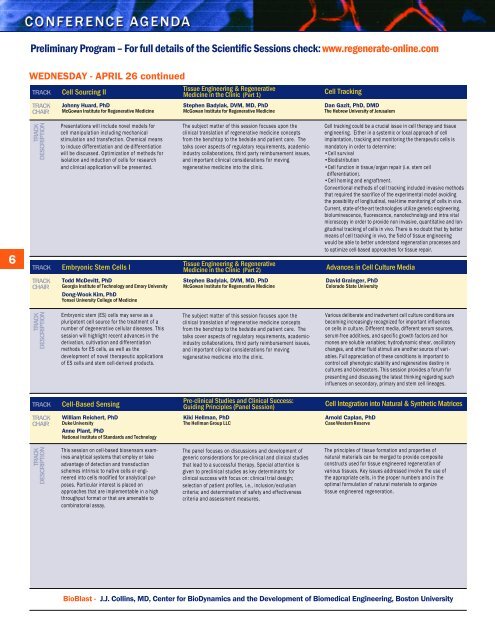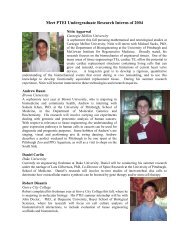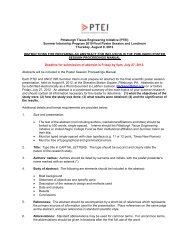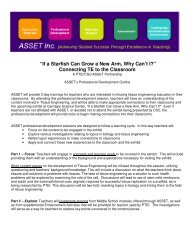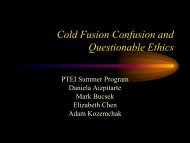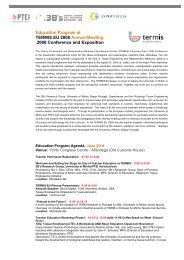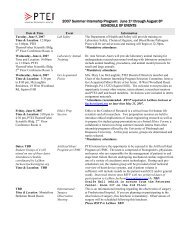SEE INSIDE - Pittsburgh Tissue Engineering Initiative
SEE INSIDE - Pittsburgh Tissue Engineering Initiative
SEE INSIDE - Pittsburgh Tissue Engineering Initiative
You also want an ePaper? Increase the reach of your titles
YUMPU automatically turns print PDFs into web optimized ePapers that Google loves.
Preliminary Program – For full details of the Scientific Sessions check: www.regenerate-online.com<br />
WEDNESDAY - APRIL 26 continued<br />
TRACK<br />
TRACK<br />
CHAIR<br />
Cell Sourcing II<br />
Johnny Huard, PhD<br />
McGowan Institute for Regenerative Medicine<br />
<strong>Tissue</strong> <strong>Engineering</strong> & Regenerative<br />
Medicine in the Clinic (Part 1)<br />
Stephen Badylak, DVM, MD, PhD<br />
McGowan Institute for Regenerative Medicine<br />
Cell Tracking<br />
Dan Gazit, PhD, DMD<br />
The Hebrew University of Jerusalem<br />
6<br />
TRACK<br />
DESCRIPTION<br />
TRACK<br />
Presentations will include novel models for<br />
cell manipulation including mechanical<br />
stimulation and transfection. Chemical means<br />
to induce differentiation and de-differentiation<br />
will be discussed. Optimization of methods for<br />
isolation and induction of cells for research<br />
and clinical application will be presented.<br />
Embryonic Stem Cells I<br />
The subject matter of this session focuses upon the<br />
clinical translation of regenerative medicine concepts<br />
from the benchtop to the bedside and patient care. The<br />
talks cover aspects of regulatory requirements, academicindustry<br />
collaborations, third party reimbursement issues,<br />
and important clinical considerations for moving<br />
regenerative medicine into the clinic.<br />
<strong>Tissue</strong> <strong>Engineering</strong> & Regenerative<br />
Medicine in the Clinic (Part 2)<br />
Cell tracking could be a crucial issue in cell therapy and tissue<br />
engineering. Either in a systemic or local approach of cell<br />
implantation, tracking and monitoring the therapeutic cells is<br />
mandatory in order to determine:<br />
•Cell survival<br />
•Biodistribution<br />
•Cell function in tissue/organ repair (i.e. stem cell<br />
differentiation).<br />
•Cell homing and engraftment.<br />
Conventional methods of cell tracking included invasive methods<br />
that required the sacrifice of the experimental model avoiding<br />
the possibility of longitudinal, real-time monitoring of cells in vivo.<br />
Current, state-of-the-art technologies utilize genetic engineering,<br />
bioluminescence, fluorescence, nanotechnology and intra vital<br />
microscopy in order to provide non invasive, quantitative and longitudinal<br />
tracking of cells in vivo. There is no doubt that by better<br />
means of cell tracking in vivo, the field of tissue engineering<br />
would be able to better understand regeneration processes and<br />
to optimize cell-based approaches for tissue repair.<br />
Advances in Cell Culture Media<br />
TRACK<br />
CHAIR<br />
Todd McDevitt, PhD<br />
Georgia Institute of Technology and Emory University<br />
Dong-Wook Kim, PhD<br />
Yonsei University College of Medicine<br />
Stephen Badylak, DVM, MD, PhD<br />
McGowan Institute for Regenerative Medicine<br />
David Grainger, PhD<br />
Colorado State University<br />
TRACK<br />
DESCRIPTION<br />
Embryonic stem (ES) cells may serve as a<br />
pluripotent cell source for the treatment of a<br />
number of degenerative cellular diseases. This<br />
session will highlight recent advances in the<br />
derivation, cultivation and differentiation<br />
methods for ES cells, as well as the<br />
development of novel therapeutic applications<br />
of ES cells and stem cell-derived products.<br />
The subject matter of this session focuses upon the<br />
clinical translation of regenerative medicine concepts<br />
from the benchtop to the bedside and patient care. The<br />
talks cover aspects of regulatory requirements, academicindustry<br />
collaborations, third party reimbursement issues,<br />
and important clinical considerations for moving<br />
regenerative medicine into the clinic.<br />
Various deliberate and inadvertent cell culture conditions are<br />
becoming increasingly recognized for important influences<br />
on cells in culture. Different media, different serum sources,<br />
serum-free additives, and specific growth factors and hormones<br />
are soluble variables; hydrodynamic shear, oscillatory<br />
changes, and other fluid stimuli are another source of vari -<br />
ables. Full appreciation of these conditions is important to<br />
control cell phenotypic stability and regenerative destiny in<br />
cultures and bioreactors. This session provides a forum for<br />
presenting and discussing the latest thinking regarding such<br />
influences on secondary, primary and stem cell lineages.<br />
TRACK<br />
Cell-Based Sensing<br />
Pre-clinical Studies and Clinical Success:<br />
Guiding Principles (Panel Session)<br />
Cell Integration into Natural & Synthetic Matrices<br />
TRACK<br />
CHAIR<br />
William Reichert, PhD<br />
Duke University<br />
Anne Plant, PhD<br />
National Institute of Standards and Technology<br />
Kiki Hellman, PhD<br />
The Hellman Group LLC<br />
Arnold Caplan, PhD<br />
Case Western Reserve<br />
TRACK<br />
DESCRIPTION<br />
This session on cell-based biosensors examines<br />
analytical systems that employ or take<br />
advantage of detection and transduction<br />
schemes intrinsic to native cells or engineered<br />
into cells modified for analytical purposes.<br />
Particular interest is placed on<br />
approaches that are implementable in a high<br />
throughput format or that are amenable to<br />
combinatorial assay.<br />
The panel focuses on discussions and development of<br />
generic considerations for pre-clinical and clinical studies<br />
that lead to a successful therapy. Special attention is<br />
given to preclinical studies as key determinants for<br />
clinical success with focus on: clinical trial design;<br />
selection of patient profiles, i.e., inclusion/exclusion<br />
criteria; and determination of safety and effectiveness<br />
criteria and assessment measures.<br />
The principles of tissue formation and properties of<br />
natural materials can be merged to provide composite<br />
constructs used for tissue engineered regeneration of<br />
various tissues. Key issues addressed involve the use of<br />
the appropriate cells, in the proper numbers and in the<br />
optimal formulation of natural materials to organize<br />
tissue engineered regeneration.<br />
BioBlast - J.J. Collins, MD, Center for BioDynamics and the Development of Biomedical <strong>Engineering</strong>, Boston University


